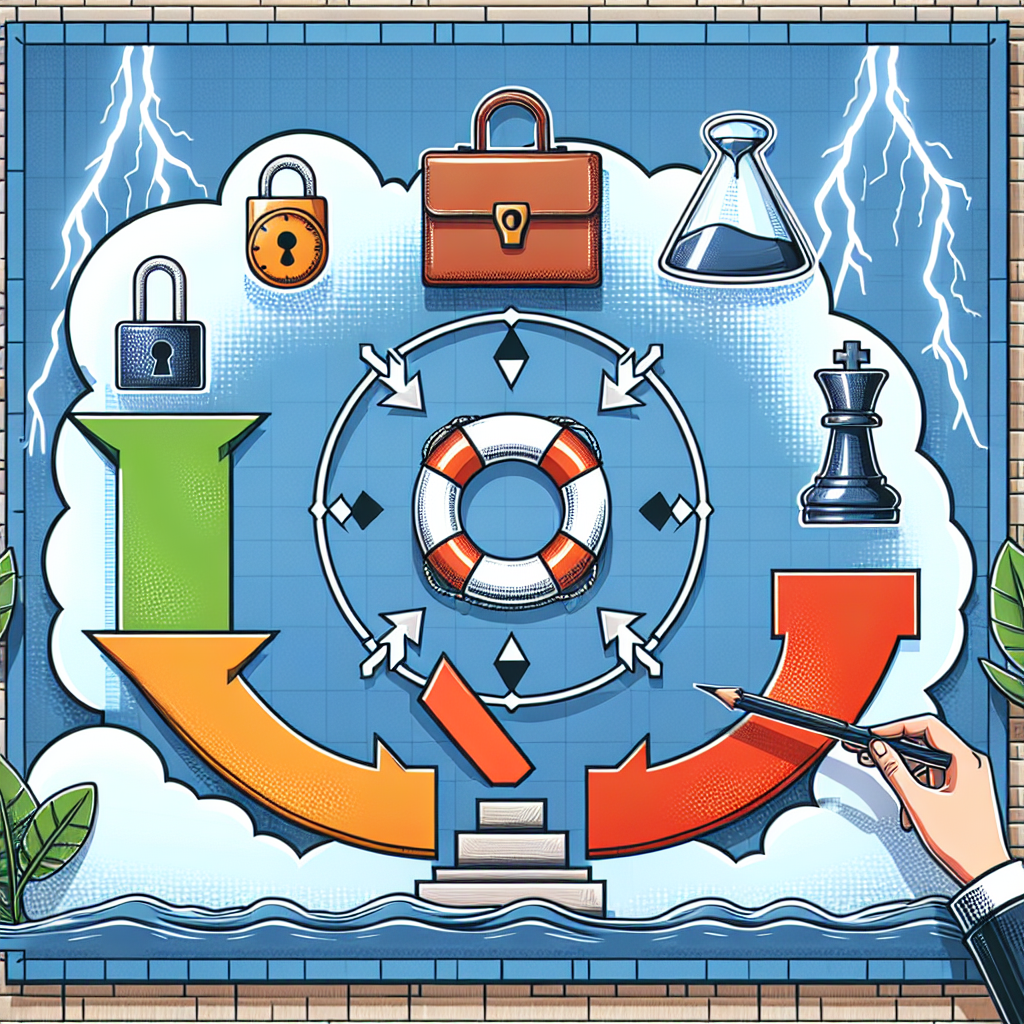Your cart is currently empty!
Tag: Times

Business Continuity in Times of Crisis: Strategies for Maintaining Operations
Business Continuity in Times of Crisis: Strategies for Maintaining OperationsIn today’s fast-paced and ever-changing business environment, organizations must be prepared to face unexpected challenges and crises that can disrupt their operations. Whether it’s a natural disaster, cyberattack, or global pandemic, having a solid business continuity plan in place is essential to ensuring the survival and success of a company.
Business continuity refers to the process of developing and implementing strategies to ensure that essential business functions can continue to operate during and after a crisis. This involves identifying potential risks, developing contingency plans, and implementing measures to minimize disruption and ensure the smooth functioning of the organization.
One of the key elements of a successful business continuity plan is having a clear understanding of the potential risks that could impact the organization. This includes conducting a thorough risk assessment to identify potential threats, such as natural disasters, supply chain disruptions, or cyberattacks. By understanding these risks, businesses can develop strategies to mitigate them and minimize their impact on operations.
Another important aspect of business continuity is developing a comprehensive crisis management plan. This plan should outline the roles and responsibilities of key personnel during a crisis, as well as the steps that need to be taken to ensure the safety of employees and the continuity of business operations. It should also include communication strategies to keep stakeholders informed and updated on the situation.
In times of crisis, organizations must be prepared to adapt and make quick decisions to ensure the continuity of their operations. This may involve implementing remote work arrangements, shifting production to alternative locations, or sourcing new suppliers to replace those that have been disrupted. By being flexible and proactive, businesses can minimize the impact of a crisis and ensure that they can continue to serve their customers and meet their obligations.
It’s also important for organizations to regularly test and update their business continuity plans to ensure that they are effective and up-to-date. This may involve conducting tabletop exercises, simulation drills, or scenario planning to identify gaps and areas for improvement. By continuously reviewing and refining their plans, businesses can ensure that they are prepared to face any challenge that comes their way.
In conclusion, business continuity is essential for organizations to survive and thrive in times of crisis. By developing a comprehensive plan, identifying potential risks, and implementing strategies to ensure the smooth functioning of operations, businesses can minimize the impact of disruptions and continue to serve their customers effectively. By prioritizing business continuity, organizations can build resilience and ensure their long-term success in an increasingly uncertain world.

Top Tips for Ensuring Business Continuity in Times of Crisis
Business continuity is essential for the survival of any organization, especially during times of crisis. Whether it’s a natural disaster, a global pandemic, or a cyber attack, having a plan in place to keep your business running smoothly is crucial. Here are some top tips for ensuring business continuity in times of crisis:1. Develop a comprehensive business continuity plan: The first step in ensuring business continuity is to have a well-thought-out plan in place. This plan should outline all the necessary steps that need to be taken in the event of a crisis, including communication protocols, backup plans, and recovery strategies.
2. Identify critical business functions: It’s important to identify the core functions of your business that are essential for its survival. This could include key personnel, critical infrastructure, and vital systems. By prioritizing these functions, you can focus your efforts on ensuring their continuity during a crisis.
3. Establish clear communication channels: Communication is key during a crisis, both internally and externally. Make sure you have clear communication channels in place so that employees, customers, and stakeholders are informed of any developments and updates.
4. Implement remote work capabilities: With the rise of remote work, it’s important to have the infrastructure in place to allow employees to work from home in the event of a crisis. This could include providing access to key systems and tools, as well as ensuring that employees have the necessary equipment to work remotely.
5. Regularly test your business continuity plan: It’s not enough to just have a plan in place – you need to regularly test it to ensure that it works effectively. Conduct drills and simulations to identify any weaknesses in your plan and make necessary adjustments.
6. Build strong relationships with suppliers and partners: In times of crisis, you may need to rely on your suppliers and partners to help keep your business running smoothly. Build strong relationships with these stakeholders so that you can work together to overcome any challenges that may arise.
7. Stay informed and adapt quickly: Crisis situations are constantly evolving, so it’s important to stay informed and adapt quickly to changing circumstances. Monitor the situation closely and be prepared to make quick decisions to ensure the continuity of your business.
By following these top tips for ensuring business continuity in times of crisis, you can help protect your organization and ensure its survival in the face of adversity. Remember, preparation is key – so take the time to develop a comprehensive plan and regularly test and update it to ensure its effectiveness.

5 Key Steps to Ensure Business Continuity in Times of Crisis
In today’s unpredictable business landscape, it is more important than ever for companies to have a solid plan in place to ensure business continuity in times of crisis. Whether it’s a natural disaster, a cyber attack, or a global pandemic, having a plan in place can mean the difference between a company surviving or shutting down.Here are 5 key steps to ensure business continuity in times of crisis:
1. Develop a Business Continuity Plan: The first step in ensuring business continuity is to develop a comprehensive business continuity plan. This plan should outline the steps that need to be taken in the event of a crisis, including who is responsible for what tasks, how communication will be handled, and what resources are available to the company.
2. Identify Critical Functions and Processes: In order to prioritize resources during a crisis, it is important to identify the critical functions and processes that are essential to the operation of the business. By focusing on these key areas, companies can ensure that they are able to continue operating even in the face of a crisis.
3. Implement Remote Work Policies: In times of crisis, it may be necessary for employees to work remotely in order to maintain business operations. Companies should have remote work policies in place that outline expectations for employees working from home, as well as provide the necessary technology and tools to enable remote work.
4. Test and Update the Plan Regularly: A business continuity plan is only effective if it is regularly tested and updated. Companies should conduct regular drills and simulations to ensure that employees are familiar with the plan and know what to do in the event of a crisis. Additionally, the plan should be updated regularly to reflect changes in the business environment and emerging threats.
5. Establish Communication Channels: Communication is key in times of crisis, both internally with employees and externally with customers and stakeholders. Companies should establish clear communication channels, such as a designated crisis communication team and a system for disseminating information quickly and efficiently.
By following these 5 key steps, companies can ensure that they are prepared to weather any crisis that may come their way. Business continuity planning is an essential part of risk management and can mean the difference between a company surviving a crisis or shutting down. It is never too early to start developing a plan and ensuring that your business is prepared for whatever the future may hold.

Data Backup and Recovery: Ensuring Business Continuity in Times of Crisis
In today’s digital age, data is one of the most valuable assets for any business. From customer information to financial records, companies rely heavily on their data to operate efficiently and effectively. However, data is also vulnerable to various threats such as cyber attacks, natural disasters, and hardware malfunctions. That’s why having a robust data backup and recovery plan in place is crucial for ensuring business continuity in times of crisis.Data backup refers to the process of creating copies of your data and storing them in a secure location. This ensures that if your original data is lost or corrupted, you can easily restore it from the backup copies. There are several methods of backing up data, including cloud storage, external hard drives, and tape backups. It’s important to regularly schedule backups to ensure that your data is always up to date.
On the other hand, data recovery is the process of restoring lost or corrupted data from backups. In the event of a data breach or system failure, having a reliable data recovery plan in place can help minimize downtime and prevent significant financial loss. Data recovery tools and services can help you quickly recover your data and get your business back up and running.
Having a comprehensive data backup and recovery plan is essential for any business, regardless of its size or industry. Here are some key benefits of implementing a data backup and recovery strategy:
1. Minimize Downtime: In the event of a data loss, having a backup of your data can help you quickly restore it and minimize downtime. This is crucial for ensuring that your business operations continue running smoothly and efficiently.
2. Protect Against Cyber Attacks: With the increasing threat of cyber attacks, having a backup of your data can help you recover quickly if your data is compromised. This can help prevent data loss and mitigate the impact of a cyber attack on your business.
3. Ensure Compliance: Many industries have strict regulations regarding data protection and security. Having a data backup and recovery plan in place can help you comply with these regulations and avoid potential legal issues.
4. Safeguard Your Reputation: Data loss can have a significant impact on your business’s reputation. By having a reliable backup and recovery plan, you can reassure your customers that their data is safe and secure.
Overall, data backup and recovery are essential components of any business continuity plan. By implementing a robust backup and recovery strategy, you can protect your data, minimize downtime, and ensure that your business continues to operate smoothly in times of crisis. Don’t wait until it’s too late – start implementing a data backup and recovery plan today to safeguard your business against potential threats.
2025 AT&T Pebble Beach Pro-Am Sunday tee times: Round 4

Rory McIlroy charged into contention ahead of the final round of the 2025 AT&T Pebble Beach Pro-Am.
Jed Jacobsohn/Getty Images
The 2025 AT&T Pebble Beach Pro-Am comes to an end on Sunday, February 2, with the final round at historic Pebble Beach. You can find full AT&T Pebble Beach Pro-Am tee times for Sunday’s final round at the bottom of this post.
Featured tee time for Round 4
On a wet and windy day at Pebble Beach, World No. 3 Rory McIlroy looked plenty comfortable. The four-time major champion fired a seven-under 65 to charge into contention ahead of Sunday’s final round.
Fellow major champion and friend Shane Lowry matched McIlroy’s 65 on Saturday to equal his total score of 15 under. But they both trail Sepp Straka, who made birdie on four of his last five holes to take back the lead at 16 under.
Players will be grouped in threesomes and play split tees on Sunday. McIlroy, Lowry and Straka will tee off in the final pairing on the front nine at 1:15 p.m. ET.
You can watch Sunday’s final round of the AT&T Pebble Beach Pro-Am from 1-3 p.m. ET on Golf Channel followed by the CBS broadcast from 3-6:30 p.m. ET. You can also stream exclusive online coverage via PGA Tour Live on ESPN+ starting at 11 a.m. ET Sunday morning.
You can check out the complete Round 4 tee times for the 2025 AT&T Pebble Beach Pro-Am below.
Get ESPN+
$11.99/month
With an ESPN+ subscription, you gain access to PGA Tour Live, where you can stream the best PGA Tour events live from wherever you want.
2025 AT&T Pebble Beach Pro-Am tee times for Sunday: Round 4 (ET)
Tee No. 1
10:52 a.m. – Gary Woodland, Akshay Bhatia, Robert MacIntyre
11:03 a.m. – Hideki Matsuyama, Davis Thompson, Keith Mitchell
11:14 a.m. – Nick Taylor, Patrick Cantlay, Andrew Novak
11:25 a.m. – Rickie Fowler, Nick Dunlap, Aaron Rai
11:36 a.m. – Eric Cole, Christiaan Bezuidenhout, Tom Hoge
11:47 a.m. – Seamus Power, Tommy Fleetwood, Viktor Hovland
11:58 a.m. – Si Woo Kim, Min Woo Lee, J.J. Spaun
12:09 p.m. – Collin Morikawa, Tony Finau, J.T. Poston
12:20 p.m. – Billy Horschel, Jake Knapp, Sam Burns
12:31 p.m. – Rasmus Højgaard, Lee Hodges, Jason Day
12:42 p.m. – Sam Stevens, Scottie Scheffler, Taylor Pendrith
12:53 p.m. – Lucas Glover, Russell Henley, Austin Eckroat
1:04 p.m. – Justin Rose, Tom Kim, Cam Davis
1:15 p.m. – Sepp Straka, Rory McIlroy, Shane LowryTee No. 10
10:52 a.m. – Chris Kirk, Sungjae Im, Justin Thomas
11:03 a.m. – Jhonattan Vegas, Thomas Detry, Sahith Theegala
11:14 a.m. – Denny McCarthy, Taylor Moore, Patrick Rodgers
11:25 a.m. – Maverick McNealy, Ben Griffin, Byeong Hun An
11:36 a.m. – Matt Fitzpatrick, Harry Hall, Brian Harman
11:47 a.m. – Will Zalatoris, Erik van Rooyen, Stephan Jaeger
11:58 a.m. – Mackenzie Hughes, Max Homa, Adam Scott
12:09 p.m. – Corey Conners, Justin Lower, Kevin Yu
12:20 p.m. – Adam Hadwin, Keegan Bradley, Doug Ghim
12:31 p.m. – Harris English, Mark Hubbard, Wyndham Clark
12:42 p.m. – Matthieu Pavon, Beau Hossler, Nico Echavarria
12:53 p.m. – Cameron Young, Max Greyserman
1:04 p.m. – Jordan Spieth, Brendon Todd
2025 AT&T Pebble Beach Pro-Am Sunday Tee Times: Round 4As the final round of the 2025 AT&T Pebble Beach Pro-Am gets underway, the tension is mounting as the top players battle it out for the coveted title. Here are the tee times for Sunday’s Round 4:
8:00 AM – Tony Finau, Viktor Hovland, Jason Day
8:10 AM – Brooks Koepka, Patrick Cantlay, Justin Rose
8:20 AM – Jordan Spieth, Phil Mickelson, Dustin Johnson
8:30 AM – Rory McIlroy, Collin Morikawa, Xander Schauffele
8:40 AM – Jon Rahm, Patrick Reed, Bryson DeChambeauThe leaderboard is tight, with just a few strokes separating the leaders. Who will emerge victorious and claim the championship at Pebble Beach? Tune in to find out!
Tags:
AT&T Pebble Beach Pro-Am, 2025, Sunday tee times, Round 4, PGA Tour, golf tournament, Pebble Beach Golf Links, professional golfers, leaderboard, final round, tee off schedule
#ATT #Pebble #Beach #ProAm #Sunday #tee #times
The Importance of Business Continuity Planning in Today’s Uncertain Times
In today’s uncertain times, businesses are facing unprecedented challenges that can disrupt operations and threaten their very survival. From natural disasters like hurricanes and earthquakes to man-made crises such as cyber-attacks and pandemics, the need for effective business continuity planning has never been greater.Business continuity planning is the process of creating a strategy to ensure that a company can continue to operate in the face of any adversity. This includes identifying potential risks, developing plans to mitigate those risks, and establishing procedures to ensure that essential functions can continue in the event of a disruption.
The importance of business continuity planning cannot be overstated, especially in today’s fast-paced and interconnected world. A well-thought-out plan can help businesses minimize the impact of disruptions, protect their reputation, and maintain customer trust. It can also help businesses comply with regulatory requirements and ensure that they are able to recover quickly and effectively from any crisis.
One of the key benefits of business continuity planning is that it can help businesses identify potential risks and vulnerabilities before they become major problems. By conducting a thorough risk assessment, businesses can proactively address potential threats and develop strategies to mitigate them. This can help businesses avoid costly downtime, lost revenue, and damage to their reputation.
In addition, business continuity planning can help businesses establish clear communication channels and lines of authority in the event of a crisis. This can help ensure that all employees are aware of their roles and responsibilities during a disruption and can help facilitate a coordinated response. Effective communication can also help businesses maintain customer trust and loyalty during a crisis.
Furthermore, business continuity planning can help businesses minimize the financial impact of a disruption. By identifying critical functions and assets, businesses can prioritize their recovery efforts and allocate resources more effectively. This can help businesses recover more quickly and reduce the overall cost of a crisis.
In conclusion, the importance of business continuity planning in today’s uncertain times cannot be overstated. By developing a comprehensive plan to address potential risks and vulnerabilities, businesses can protect their operations, their reputation, and their bottom line. Investing in business continuity planning can help businesses weather any storm and emerge stronger and more resilient in the face of adversity.
Is there an NFL game today? Full schedule, TV channels, live streams, times for 2025 Pro Bowl and Super Bowl
The Super Bowl 59 matchup is set, with the Chiefs vying for a three-peat in a rematch of Super Bowl 57 against the Eagles.
As we await kickoff on Sunday, Feb. 9, storylines abound. Eight teams have won back-to-back Super Bowls, but no one has won three straight. Can Patrick Mahomes and Kansas City’s unrelenting dynasty achieve that feat?
Or will Philadelphia pull off its redemption arc, winning its second Super Bowl in eight years? Surely Saquon Barkley, whose domineering postseason carried the Eagles through the NFC, will have a say in that outcome.
In the meantime, the NFL bridges the layoff with the Pro Bowl Games. An exhilarating slate of competitions — headlined by a flag football game — involving the league’s best players is set for Sunday, Feb. 2.
The Sporting News gets you set for everything that you need to know about this weekend’s NFL activities.
Is there an NFL game today?
No, there is not an NFL game today. Super Bowl 59 between the Chiefs and the Eagles will take place Sunday, Feb. 9.
In the meantime, viewers can tune into the Pro Bowl Games on Sunday, Feb. 2 beginning at 3 p.m. ET.
NFL playoff schedule 2025
Super Bowl 59
Sunday, Feb. 9
Matchup Time (ET) TV Live stream Chiefs vs. Eagles 6:30 p.m. Fox Fubo How to watch the 2025 Pro Bowl
- TV channels: ESPN | ABC
- Live stream: Fubo (U.S.)
The 2025 NFL Pro Bowl Games will conclude on Sunday, Feb. 2, airing simultaneously on ESPN and ABC.
Viewers in the U.S. can stream the Pro Bowl live with Fubo, which offers a free trial, so you can try before you buy.
For a limited time, you can get your first month of Fubo for as low as $59.99, a $25 savings. Stream ESPN, ABC, CBS, Fox, NBC and 200+ top channels of live TV and sports without cable. (Participating plans only. Taxes and fees may apply.)
Related Links
Yes, there is an NFL game today! Here is the full schedule for the 2025 Pro Bowl and Super Bowl along with TV channels, live streams, and times:– 2025 Pro Bowl: The Pro Bowl will be held on Sunday, January 26, 2025 at Allegiant Stadium in Las Vegas, Nevada. The game will kick off at 3:00 PM ET and will be broadcast on NBC. Fans can also stream the game live on the NBC Sports app or website.
– 2025 Super Bowl: The Super Bowl will take place on Sunday, February 9, 2025 at Mercedes-Benz Superdome in New Orleans, Louisiana. The game will start at 6:30 PM ET and will be aired on NBC. Viewers can also watch the Super Bowl live on the NBC Sports app or website.
So grab your snacks, gather your friends and family, and get ready for some exciting NFL action with the 2025 Pro Bowl and Super Bowl!
Tags:
NFL game today, NFL schedule, NFL TV channels, NFL live streams, NFL game times, 2025 Pro Bowl schedule, 2025 Super Bowl schedule, NFL game updates, NFL game info, NFL game coverage.
#NFL #game #today #Full #schedule #channels #live #streams #times #Pro #Bowl #Super #Bowl
The Importance of Disaster Recovery Plans: How to Protect Your Business in Times of Crisis
In today’s fast-paced world, businesses face a multitude of risks that can threaten their operations at any given moment. Natural disasters, cyber attacks, and other unforeseen events can disrupt business activities, leading to financial losses and reputational damage. In times of crisis, having a solid disaster recovery plan in place is crucial to protect your business and ensure its survival.A disaster recovery plan is a documented set of procedures and strategies that outline how a business will respond to and recover from a disaster or emergency situation. This plan should address various scenarios, such as data breaches, power outages, and natural disasters, and provide guidelines on how to resume operations as quickly as possible.
One of the key benefits of having a disaster recovery plan is that it helps businesses minimize downtime and ensure business continuity in the event of a disaster. By having a plan in place, businesses can quickly assess the situation, prioritize critical tasks, and implement recovery strategies to get back up and running in a timely manner.
Moreover, a well-developed disaster recovery plan can also help businesses protect their data and assets. In the event of a cyber attack or data breach, having a plan in place can help businesses recover lost or compromised data, prevent further damage, and safeguard sensitive information.
Additionally, having a disaster recovery plan can enhance a business’s reputation and build trust with customers and stakeholders. By demonstrating that the business is prepared for unforeseen events and can quickly recover from disasters, businesses can instill confidence in their ability to weather crises and continue to deliver products and services to their customers.
So, how can businesses create an effective disaster recovery plan to protect their operations in times of crisis? Here are some key steps to consider:
1. Identify potential risks and vulnerabilities: Conduct a thorough risk assessment to identify potential threats to your business, such as natural disasters, cyber attacks, and human errors. Understanding these risks will help you develop a plan that addresses specific challenges and vulnerabilities.
2. Develop a comprehensive plan: Create a detailed disaster recovery plan that outlines the steps to take in the event of a disaster, including communication protocols, data backup procedures, and recovery strategies. Make sure to involve key stakeholders in the planning process and regularly review and update the plan as needed.
3. Test and train employees: Regularly test your disaster recovery plan through simulation exercises and drills to ensure that it is effective and can be implemented smoothly in a real-life scenario. Train employees on their roles and responsibilities during a crisis to ensure a coordinated response.
4. Backup data and resources: Implement a robust data backup and recovery system to protect critical information and assets. Store backups in secure offsite locations to ensure that data can be retrieved in the event of a disaster.
5. Monitor and review: Continuously monitor and assess the effectiveness of your disaster recovery plan, and make adjustments as needed to address new threats or changes in the business environment. Regularly review and update the plan to ensure that it remains relevant and up-to-date.
In conclusion, having a solid disaster recovery plan is essential for businesses to protect their operations and ensure business continuity in times of crisis. By proactively preparing for potential risks and developing a comprehensive plan, businesses can minimize downtime, protect their data and assets, and maintain trust with customers and stakeholders. Investing in disaster recovery planning is a smart and strategic decision that can help businesses navigate through unforeseen events and emerge stronger on the other side.

Ensuring Business Continuity in Times of Crisis: Best Practices for Resilient Organizations
In today’s fast-paced and unpredictable business environment, organizations must be prepared to face unexpected crises that can disrupt their operations. From natural disasters to cyberattacks, from pandemics to economic downturns, there are a myriad of potential threats that can jeopardize a company’s ability to function effectively. In order to ensure business continuity in times of crisis, organizations must adopt best practices that will help them build resilience and weather any storm that comes their way.One of the key best practices for ensuring business continuity in times of crisis is to develop a comprehensive business continuity plan. This plan should outline the steps that the organization will take to ensure that essential functions can continue even in the face of a crisis. It should include detailed procedures for responding to different types of emergencies, as well as a clear chain of command for decision-making during a crisis. Regularly updating and testing this plan is crucial to ensure that it remains effective and relevant in the event of a crisis.
Another important best practice for resilient organizations is to invest in robust IT infrastructure and cybersecurity measures. In today’s digital age, cyberattacks are a constant threat to businesses of all sizes. By implementing strong cybersecurity protocols and investing in secure IT systems, organizations can minimize the risk of a data breach or other cyber incident that could disrupt their operations. Regularly backing up data and implementing disaster recovery measures are also essential components of a strong IT infrastructure that can help ensure business continuity in times of crisis.
Effective communication is another critical best practice for ensuring business continuity in times of crisis. During a crisis, clear and timely communication is essential to keep employees, customers, and other stakeholders informed and engaged. Organizations should establish communication protocols and channels in advance, so that they can quickly disseminate important information when a crisis occurs. Maintaining open lines of communication with employees and stakeholders can help build trust and confidence in the organization’s ability to weather the storm.
Finally, building a culture of resilience within the organization is key to ensuring business continuity in times of crisis. This includes fostering a mindset of adaptability, creativity, and collaboration among employees, as well as creating a supportive work environment that encourages innovation and problem-solving. By cultivating a resilient culture, organizations can better navigate and overcome the challenges that arise during a crisis, and emerge stronger and more prepared for future challenges.
In conclusion, ensuring business continuity in times of crisis requires a proactive and strategic approach that incorporates best practices for resilience. By developing a comprehensive business continuity plan, investing in IT infrastructure and cybersecurity, maintaining effective communication, and building a culture of resilience, organizations can better prepare themselves to face and overcome any crisis that comes their way. By implementing these best practices, organizations can safeguard their operations, protect their reputation, and ensure their long-term success in an increasingly uncertain world.

Beyond Backup: How Disaster Recovery Plans Save Businesses in Times of Crisis
In today’s digital age, data is the lifeblood of businesses. From customer information to financial records, companies rely heavily on data to operate and make informed decisions. However, with the increasing frequency of cyber attacks, natural disasters, and other unexpected events, the risk of data loss has never been higher. That’s where disaster recovery plans come into play.A disaster recovery plan is a comprehensive strategy that outlines how a business will recover and restore critical data and systems in the event of a disaster. This plan typically includes measures such as regular data backups, redundancy in systems, and clear protocols for responding to emergencies.
One of the key components of a disaster recovery plan is data backup. Regularly backing up data ensures that even if a disaster strikes, the business can quickly recover and resume operations. Beyond simply backing up data, businesses must also ensure that these backups are secure, easily accessible, and regularly tested to ensure their effectiveness.
In times of crisis, having a well-thought-out disaster recovery plan can mean the difference between a business surviving or crumbling under the pressure. For example, in the event of a cyber attack that compromises critical data, a disaster recovery plan can help businesses quickly isolate the threat, restore data from backups, and minimize downtime.
Natural disasters such as hurricanes, floods, or fires can also wreak havoc on businesses, causing widespread damage and data loss. In these situations, a disaster recovery plan can help businesses quickly recover essential data and systems, enabling them to continue serving their customers and staying afloat during challenging times.
Moreover, having a disaster recovery plan in place can also help businesses comply with regulatory requirements and protect their reputation. In today’s interconnected world, customers expect businesses to safeguard their information and ensure business continuity, even in the face of unforeseen events.
Ultimately, investing in a robust disaster recovery plan is not just about protecting data – it’s about safeguarding the future of the business. By proactively planning for emergencies and implementing measures to mitigate risks, businesses can ensure their resilience and ability to bounce back from any crisis.
In conclusion, beyond backup, disaster recovery plans are essential for businesses looking to navigate the unpredictable landscape of today’s business environment. By investing in a comprehensive disaster recovery plan, businesses can protect their data, maintain operations during crises, and ultimately secure their future success.


